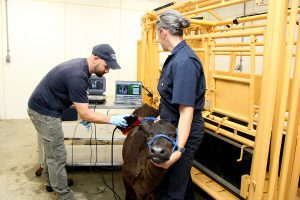
Article by Joe Emenheiser, Ph.D.
Meat quality improvement can improve economic development for livestock producers. Ultrasound technology is used to evaluate body composition traits. This means livestock producers can check meat qualities in live animals. It leads to better livestock selection and breeding decisions.
A three-year grant project on beef and dairy crossbreeding is improving growth and carcass composition. Dairy farms are using more beef x dairy crossbreeding because of milk price volatility and decreased value of replacement dairy heifers. Beef prices and demand are also strong. Beef and dairy crossbreeding are not new, but we have not studied it with modern genetics. Our team is looking at the effects and economics of different management practices.
We ultrasound UConn crossbred calves monthly and evaluate the effects of different nutrition protocols. Our team considers this information along with data on calf performance, carcass value, and cost of production. It informs Extension programming and recommendations for livestock producers.
Northeast SARE funds this project. Collaborators are Drs. Sarah Reed, Kristen Govoni, and Steve Zinn from the UConn Animal Science Department and Dr. Tara Felix from Penn State University.